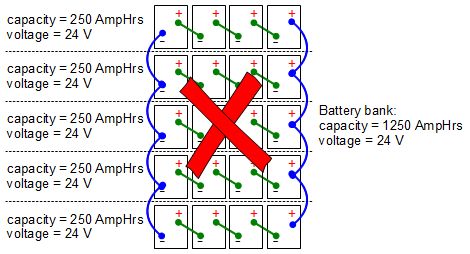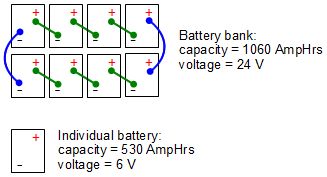NOTE: Clicking on any link in the body portion of this page will take you to a new window or tab so that you don't lose any information.
The next step is to figure out how many and which batteries you'll need. You'll likely need more than one battery. The collection of all your batteries is referred to as your battery bank.
Part A - Find out your battery bank capacity
You'll need to know the total capacity for all your batteries put together that'll meet your power needs. This is like finding out how many gallons of water you need to store for your various water uses. Follow the steps in the following battery bank capacity calculator.
Part B - Selecting the batteries
|
There are 4 values you'll have to find out while selecting batteries (see the drawing on the right):
- Capacity of your battery bank - You already got that from the above calculator.
- Voltage of your battery bank - You already selected a voltage in the second input in the above calculator, though you may change your mind either during this part or later.
- Individual battery voltage - Each battery will have the same voltage and it'll likely be less than the battery bank voltage.
- Individual battery capacity - Just as the battery bank has a capacity, so too does each battery in that battery bank. This will be the same for each battery.
Now that you know the values to look for, you can now look at some batteries. Two very reputable, high quality, long lasting makes of batteries are Trojan and Surrette (known as Rolls in the US). In the past Trojan made smaller capacity batteries than Surrette and so was suitable for smaller solar systems. They now make larger ones too. (Disclaimer: I have no affiliation with either these companies. These are two that I've worked with and know of their reputation. There are of course others too but I can't use all of them as examples.)
Our example
Let's say we started with the following values:
 |
Putting the above values into the above calculator, the needed battery bank capacity we get back is 1013 AmpHrs. A good fit for this is the Surrette S-530. Each S-530 battery has a capacity of 530 AmpHrs and a voltage of 6 V. This may not sound good since our example needs a battery bank capacity of 1013 AmpHrs and 24 V but that just means we'd need more than one battery.
Why did I start with the S-530? Because 530 AmpHrs is a little more than half the needed 1013 AmpHrs. Or put another way, 2 x 530 = 1060, a little more than 1013. This 2x is important and you'll see why when you learn below about not paralleling batteries more than 2 times. For now, ignore the why. I basically picked a battery whose individual battery capacity was either close to the needed capacity or that I could multiply by 2 and get the same or a litte more than the needed capacity.
Getting the voltages to add up - connecting in series
How many S-530 batteries do we need? Let's start with getting 24 V by using more than one of our 6 V batteries. To get the voltages of batteries to add up you connect the batteries together in series. Connecting in series causes their voltages to add up. Since we need 24 V, we'll need 4 batteries:
24 V / 6 V per battery = 4 batteries
or
6 V x 4 = 24 V
Each battery has two terminals, two places to connect wires to: a positive (+) terminal and a negative (-) terminal.
Connecting in series means connecting the positive terminal of one battery to the negative terminal of the next battery. This results in a string of batteries as shown below with the green connections.
 |
Notice above that we've labelled this as a new battery bank with a capacity of 530 AmpHrs and a voltage of 24 V. Only the voltages added up. Even though each battery by itself is 530 AmpHrs, when connecting in series the capacities of the batteries DON'T add up.
Getting the capacities to add up - connecting in parallel
Next we need to use multiple of our 530 AmpHr batteries to add up to our needed 1013 AmpHrs. Connecting in parallel causes the capacities (or amps hours) to add up. Since we need 1013 AmpHrs, we'll need 2 sets of batteries:
1013 AmpHrs / 530 AmpHrs per battery = 2 batteries (well 1.9, close enough)
or
530 AmpHrs x 2 = 1060 AmpHrs (a little more than we need)
How do we connect them in parallel? For parallel connect the postive terminals together and the negative terminals together, as shown below with the blueconnections.
 |
Notice above that we treated each series string of four batteries as if they each consisted of just one battery and we used only the end terminals. That's how you connect series strings together in parallel.
Notice above that just because we have 8 6 V batteries in total, we don't have a 48 V battery bank. Connecting in parallel causes the capacities to add up but not the voltages. So in parallel, 24 V + 24 V = 24 V! Only the capacities add up.
Avoid using more than 2 parallel strings!
Since we magically started with a good choice for batteries, what if we'd started with something smaller like the Trojan T-105 instead? The T-105 has a capacity of 250 AmpHrs and a voltage of 6 V. So we'd again put 4 in series to add the voltages up to 24 V. To get our 1013 AmpHrs, we'd need to put 5 of our 24 V series strings in parallel to get a total capacity of 1250 AmpHrs (5 x 250). It would look like the following.
 |
The big problem with the above is that there are 5 series strings connected in parallel. You should avoid paralleling more than 2 series strings together. The above has 3 series strings too many. Having too many in parallel results in uneven charging of batteries with the batteries in the middle being used less than the batteries at the ends. The middle batteries will have a different lifetime than the end ones.
There's nothing wrong with the T-105, it's a good battery and I've used it, but it's too small for the above example. If for some reason you want a Trojan battery instead of a Surrette than there's the Trojan IND9-6V which is 545 AmpHrs and 6 V, which works out to 8 batteries with 2 parallel strings of 4 each in series, just like the Surrette S-530 example above.
Amp hour rates: 20 AmpHr rate vs 100 AmpHr rate
Oddly enough, the speed at which you discharge a battery affects how much you can get out of the battery. The faster you discharge it the less you'll get out of it. It's as if pouring water quickly out of a bucket results in there being less water in the bucket to start with than if you'd poured it out slowly! So if a battery is rated as having a 530 AmpHr capacity, whether or not that's true depends on how you use the battery.
To make up for this, battery manufacturers give multiple capacity ratings for their batteries. The Surrette S-530 for example can have a capacity of:
- 532 AmpHrs with a 100 hour rating or
- 400 AmpHrs with a 20 hour rating.
The above 100 hour rating means you will be discharging the battery in 100 hours by using 5.32 amps continuously for 100 hours (532 / 100). The above 20 hour rating means you will be discharging the battery in 20 hours by using 20 amps continuously for 20 hours (400 / 20).
For off-grid systems it's usually expected you'll use the 100 hour rating, i.e. you've purchased a large enough battery bank so that you won't be using it too heavily. The more often you charge and then discharge a battery, the shorter its lifetime. Off-gridders typically try to make their batteries last a long time since they cost a lot. Industrial users typically use the shorter lived, more costly 20 hour rate.
Some solar suppliers will recommend the 20 hour rate. Two possible reasons for this are to either sell more batteries (the 20 hour rate has a smaller capacity) or they realize that a lot of people underestimate their power needs and end up using their batteries heavily. I can easily believe the second reason since I've seen this happen enough times myself.
The end result for step 2
You've now figured out which batteries you'll need, how many and how you'll connect them together (series/parallel). Click on an icon at the top or bottom of this page to go to another step.
NOTE: Clicking on any link in the body portion of this page will take you to a new window or tab so that you don't lose any information.


ليست هناك تعليقات:
إرسال تعليق